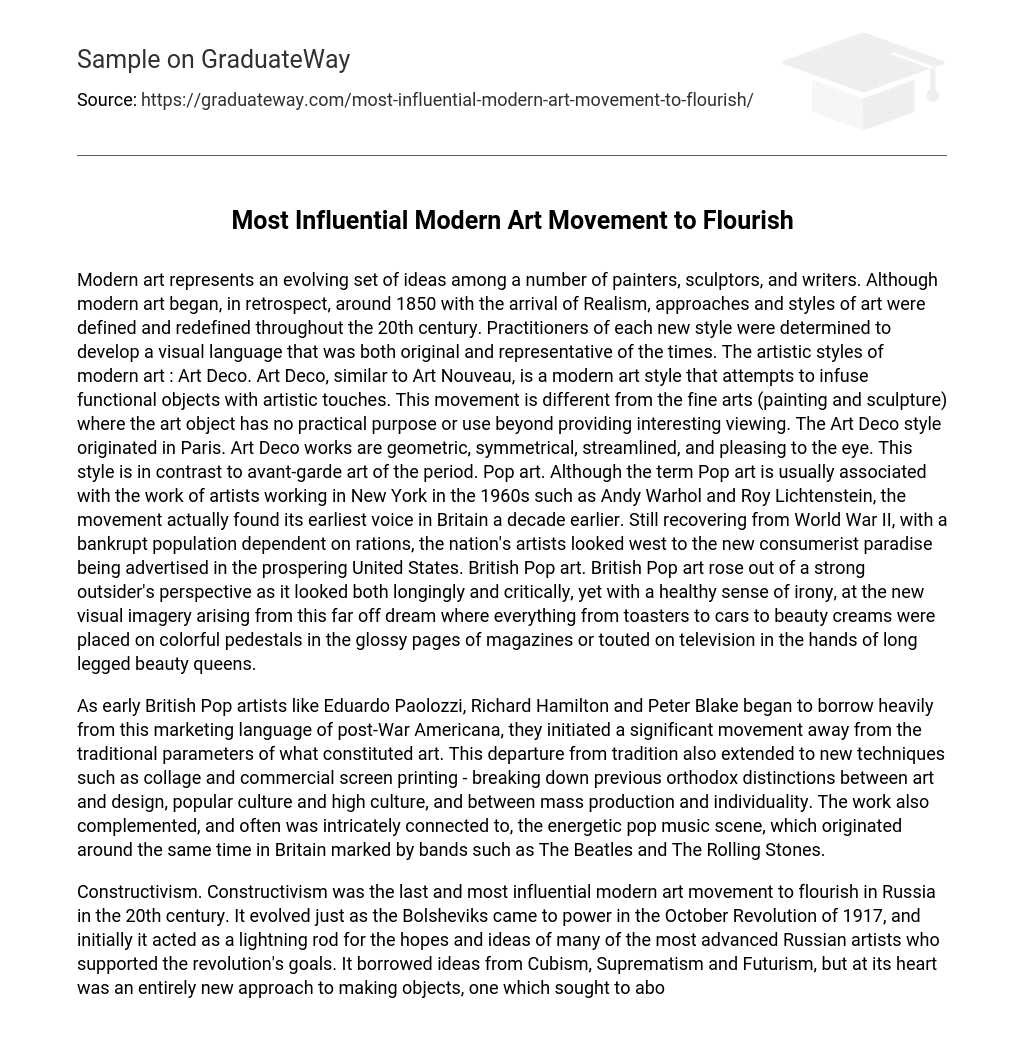Modern art represents an evolving set of ideas among a number of painters, sculptors, and writers. Although modern art began, in retrospect, around 1850 with the arrival of Realism, approaches and styles of art were defined and redefined throughout the 20th century. Practitioners of each new style were determined to develop a visual language that was both original and representative of the times. The artistic styles of modern art : Art Deco. Art Deco, similar to Art Nouveau, is a modern art style that attempts to infuse functional objects with artistic touches. This movement is different from the fine arts (painting and sculpture) where the art object has no practical purpose or use beyond providing interesting viewing. The Art Deco style originated in Paris. Art Deco works are geometric, symmetrical, streamlined, and pleasing to the eye. This style is in contrast to avant-garde art of the period. Pop art. Although the term Pop art is usually associated with the work of artists working in New York in the 1960s such as Andy Warhol and Roy Lichtenstein, the movement actually found its earliest voice in Britain a decade earlier. Still recovering from World War II, with a bankrupt population dependent on rations, the nation’s artists looked west to the new consumerist paradise being advertised in the prospering United States. British Pop art. British Pop art rose out of a strong outsider’s perspective as it looked both longingly and critically, yet with a healthy sense of irony, at the new visual imagery arising from this far off dream where everything from toasters to cars to beauty creams were placed on colorful pedestals in the glossy pages of magazines or touted on television in the hands of long legged beauty queens.
As early British Pop artists like Eduardo Paolozzi, Richard Hamilton and Peter Blake began to borrow heavily from this marketing language of post-War Americana, they initiated a significant movement away from the traditional parameters of what constituted art. This departure from tradition also extended to new techniques such as collage and commercial screen printing – breaking down previous orthodox distinctions between art and design, popular culture and high culture, and between mass production and individuality. The work also complemented, and often was intricately connected to, the energetic pop music scene, which originated around the same time in Britain marked by bands such as The Beatles and The Rolling Stones.
Constructivism. Constructivism was the last and most influential modern art movement to flourish in Russia in the 20th century. It evolved just as the Bolsheviks came to power in the October Revolution of 1917, and initially it acted as a lightning rod for the hopes and ideas of many of the most advanced Russian artists who supported the revolution’s goals. It borrowed ideas from Cubism, Suprematism and Futurism, but at its heart was an entirely new approach to making objects, one which sought to abolish the traditional artistic concern with composition, and replace it with ‘construction.’ Constructivism called for a careful technical analysis of modern materials, and it was hoped that this investigation would eventually yield ideas that could be put to use in mass production, serving the ends of a modern, Communist society. Ultimately, however, the movement floundered in trying to make the transition from the artist’s studio to the factory. Some continued to insist on the value of abstract, analytical work, and the value of art per se; these artists had a major impact on spreading Constructivism throughout Europe.
Others, meanwhile, pushed on to a new but short-lived and disappointing phase known as Productivism, in which artists worked in industry. Russian Constructivism was in decline by the mid 1920s, partly a victim of the Bolshevik regime’s increasing hostility to avant-garde art. But it would continue to be an inspiration for artists in the West, sustaining a movement called International Constructivism which flourished in Germany in the 1920s, and whose legacy endured into the 1950s. Conceptualism. Conceptualism took myriad forms, such as performances, happenings, and ephemera. From the mid-1960s through the mid-1970s Conceptual artists produced works and writings that completely rejected standard ideas of art. Their chief claim – that the articulation of an artistic idea suffices as a work of art – implied that concerns such as aesthetics, expression, skill and marketability were all irrelevant standards by which art was usually judged. So drastically simplified, it might seem to many people that what passes for Conceptual art is not in fact ‘art’ at all, much as Jackson Pollock’s ‘drip’ paintings, or Andy Warhol’s Brillo Boxes (1964), seemed to contradict what previously had passed for art.
But it is important to understand Conceptual art in a succession of avant-garde movements (Cubism, Dada, Abstract Expressionism, Pop, etc.) that succeeded in self-consciously expanding the boundaries of art. Conceptualists put themselves at the extreme end of this avant-garde tradition. In truth, it is irrelevant whether this extremely intellectual kind of art matches one’s personal views of what art should be, because the fact remains that Conceptual artists successfully redefine the concept of a work of art to the extent that their efforts are widely accepted as art by collectors, gallerists, and museum curators. By the end of the 1970s, when cultural critics began speaking of ‘the end of painting’ new media art had become a category in itself, with a growing number of artists experimenting with technological means such as video art. Painting assumed renewed importance in the 1980s and 1990s, as evidenced by the rise of neo-expressionism and the revival of figurative painting. Towards the end of the 20th century, a number of artists and architects started questioning the idea of ‘the modern’ and created typically Postmodern works.





